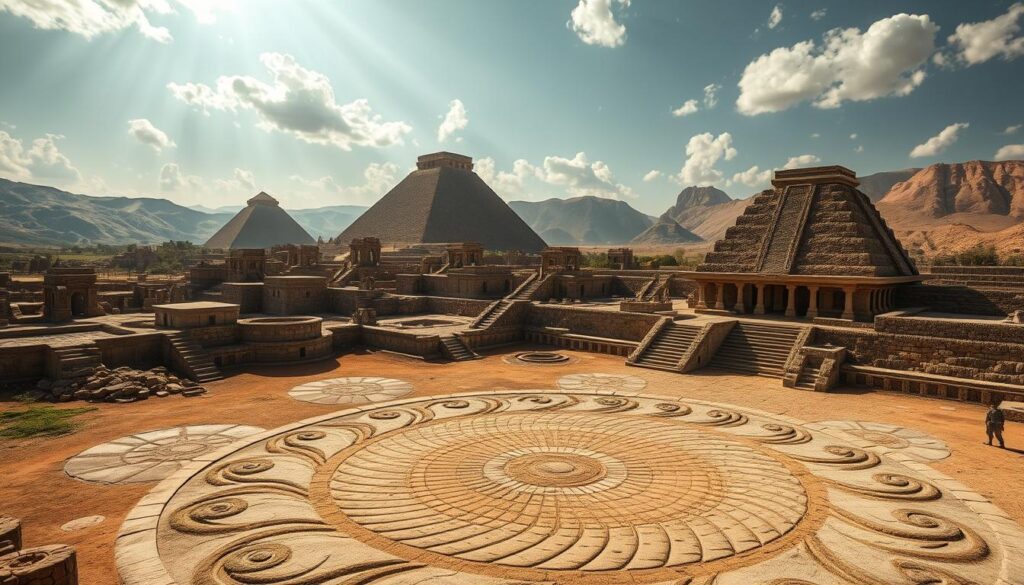Fractals let us peek into ancient secrets and understand history better. This method isn’t just math; it’s a way to see patterns that shaped societies. We see fractals in great buildings and art, showing they’re part of our legacy.
Looking at fractals in different areas highlights deep ties between our past and nature. This approach sheds light on our connection with the environment.
The Fascinating Intersection of Fractals and History
Exploring history through fractals offers a unique perspective. These complex patterns highlight connections in ancient designs and growth. It shows how societies expressed their world view through geometry.
Fractals pop up in ancient buildings, like temples. They show a consistent geometric theme, hinting at a universal mathematical order. Experts use fractal analysis to link different historical times.
Fractals also help us understand complex social dynamics. They reveal how ancient civilizations developed and related to each other. This blend of math and history brings new depth to our understanding of human civilization.

Understanding Fractals: Nature’s Patterns
Fractals are at the crossroads of math and nature. They show patterns that repeat on different scales. When we look at nature’s details, we see a complex design. Patterns in trees and snowflakes are examples of fractal geometry.
Nature’s use of fractals shows the elegance of math. Natural processes form intricate shapes with simple rules, making the most out of resources. Coastlines, mountain ranges, and clouds display fractal patterns. Benoit Mandelbrot’s studies in the late 20th century linked nature with math.
Fractals and nature together help us get why the environment is the way it is. These patterns are crucial, not just mathematical tricks.
Fractals in Biological Structures
Fractals play a big role in the design and functioning of biological structures in living organisms. They help us understand complex systems like human anatomy better.
Fractals are found in organ systems, making them work more efficiently and effectively.
The Role of Fractals in Human Anatomy
Fractals help shape many biological systems in humans. For instance, the complex network of blood vessels ensures efficient blood flow.
This fractal design increases surface area, helping oxygen and nutrients reach all cells. Similarly, the lungs’ tree-like structure boosts gas exchange, thanks to its vast surface.
Examples from Nature: Lungs and Trees
In nature, the lungs and trees offer amazing examples of fractals. Their branching structures improve their functions.
The lungs’ alveoli have a fractal design that boosts oxygen transfer. This is similar to how tree roots spread to find water and nutrients.
These examples show fractals’ importance not just in theory but in actual life processes.
The Contributions of Benoit Mandelbrot
Benoit Mandelbrot is known as the father of fractal geometry. This field changed how we see complex patterns. His work introduced the idea of self-similarity. This idea is key in studying both natural and mathematical forms.
His book, “The Fractal Geometry of Nature,” showed the complex structures in nature. It connected math to the real world. Mandelbrot’s work opened eyes to new geometric shapes, moving beyond smooth lines.
His ideas led to new research in science and art. Fractal geometry helps find order in chaos. Benoit Mandelbrot’s work didn’t just push math forward. It also got people excited about fractals in different areas.
Fractal Analysis in Ancient Architecture
Fractal analysis shows us a special way to look at old architecture’s amazing designs. The Egyptian pyramids are a key example. They use geometric patterns in a smart way. This shows the builders knew about fractals. And this knowledge made these big buildings both beautiful and strong.
Uncovering Patterns in the Pyramids
Studies show the pyramids have patterns like those in fractal geometry. Their shape and design might be based on math. Ancient builders likely used these ideas on purpose. This shows they were advanced in engineering.
Mayan Structures and Fractal Geometry
Mayan architecture also uses fractal geometry. Their buildings and temples have detailed patterns. These patterns are like those in nature. They show the Mayans’ skill in building. And they made their structures more stable and good-looking.
Fractal Analysis and Art: The Works of Katsushika Hokusai
Katsushika Hokusai is known for his Japanese woodblock prints. His famous work, “The Great Wave off Kanagawa,” shows a special link to fractals. The wave patterns in this piece echo smaller repeating shapes, showing nature’s complex beauty.
Art experts often say Hokusai skillfully uses nature to merge art with math. His works, like “The Great Wave,” make us see a dance between the two. It’s like he knew about fractals long before they were defined by science.
Hokusai had a knack for capturing waves and motion in a way that feels alive. By studying his art through fractals, we see a hidden structure. It makes his work more intriguing, connecting art deeper with science.
Hokusai’s prints are more than just beautiful. They show how fractal analysis can deepen our understanding of art. They bridge natural forms and artistic creation. This invites everyone, artists and mathematicians alike, to admire both fields even more.
Uncovering Ancient Knowledge Through Fractal Analysis
Fractal analysis is a unique way to study ancient knowledge and history. It finds repeating patterns in old artifacts and structures from many cultures. Through this, researchers can see how these cultures are connected over time and space.
This method shows how different societies are linked. It sheds light on shared methods and influences between them.
How Fractals Help Understand Historical Contexts
Using fractal analysis, historians can learn how ancient societies interacted. They look at fractal patterns across cultures to find moments of contact or similar developments. This helps show how these societies might have shared ideas or solutions to face common problems.
Fractals Revealing Cultural Patterns
Looking at artifacts through fractal analysis reveals deep cultural patterns. These patterns are found in pottery, architecture, and textiles. They show more than just beauty; they reveal beliefs and values shared by ancient peoples.
This approach helps us understand how ancient civilizations were deeply interlinked. It gives us a deeper insight into their shared heritage.
Fractals and the Psychology of Perception
Fractals have a big impact on how we see and interpret things. Studies show that simpler fractal patterns make it easier to recognize shapes. This is very clear with Rorschach inkblots where easy fractal designs lead to simpler ideas of what is seen.
The link between fractals and psychology shows how visual complexity connects with our understanding. When looking at fractal patterns, people are drawn to certain parts. This greatly affects how they experience art and nature. These connections offer clues about how our brains process beauty in what we see.
Using fractals in therapy offers psychologists a creative way to help people. It lets them explore how we find order in chaos and understand hidden emotions. This method can make emotions that seemed too complex easier to explain. Studying fractals helps us get a better grasp of perception itself.
Applications of Fractal Analysis in Modern Science
Fractal analysis is widely used in many science fields today. It’s important in physics, biology, and engineering. Doctors use fractal methods to better diagnose and treat illnesses. For example, studying how blood vessels form patterns helps with heart disease research.
Fractal analysis also helps environmental scientists. They use it to map out landscapes and study weather trends. This makes understanding our environment easier. It shows how everything in nature is connected.
Using fractals in different areas of science brings new insights. It’s a key tool for researchers wanting to link different types of knowledge. Fractal analysis keeps showing us new ways to improve research and our understanding of the world.
Fractals in Wireless Communication and Technology
Fractals are shaping the future of wireless communication, especially in making antennas. These antennas use repeating geometric shapes to work on many frequency bands. This makes them small yet powerful.
Using fractals in wireless tech brings big benefits:
- Improved transmission and reception capabilities across various frequencies.
- Reduction in physical size while maintaining high efficiency levels.
- Increased bandwidth, making devices more versatile in their functionality.
Fractals link math and engineering to improve our tech world. As wireless tech grows, fractals play a key role in making better connections.
Conclusion
Exploring fractal analysis changes how we see ancient knowledge and nature’s complex patterns. This article shows fractals in different areas, linking history, culture, and biology.
By studying fractals more, we find ideas connecting our past, present, and future. Fractals have a big role in many fields, like art and science, pushing for teamwork across disciplines.
This talk pushes for more research on fractals, making us value world complexity more. With ongoing fractal studies, we might find new ways to understand our place in the universe.



